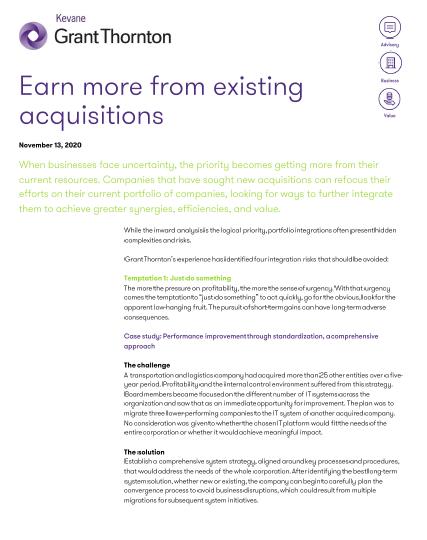While the inward analysis is the logical priority, portfolio integrations often present hidden complexities and risks.
Grant Thornton’s experience has identified four integration risks that should be avoided:
Temptation 1: Just do something
The more the pressure on profitability, the more the sense of urgency. With that urgency comes the temptation to “just do something” to act quickly, go for the obvious, look for the apparent low-hanging fruit. The pursuit of short-term gains can have long-term adverse consequences.
Case study: Performance improvement through standardization, a comprehensive approach
The challenge
A transportation and logistics company had acquired more than 25 other entities over a five-year period. Profitability and the internal control environment suffered from this strategy. Board members became focused on the different number of IT systems across the organization and saw that as an immediate opportunity for improvement. The plan was to migrate three lower-performing companies to the IT system of another acquired company. No consideration was given to whether the chosen IT platform would fit the needs of the entire corporation or whether it would achieve meaningful impact.
The solution
Establish a comprehensive system strategy, aligned around key processes and procedures, that would address the needs of the whole corporation. After identifying the best long-term system solution, whether new or existing, the company can begin to carefully plan the convergence process to avoid business disruptions, which could result from multiple migrations for subsequent system initiatives.
Extract value and avoid 4 common temptations.
As you conduct your fraud risk assessment, match your identified fraud risks to your identified anti-fraud controls. Once you assess and score risks, leverage this inventory to understand what controls are in place to combat a known risk and to understand how strong those controls are in practice. Far too many organizations fail to perform this risk-to-control mapping, and this results in controls that are not fit for their purpose and/or do not address specific kinds of demonstrable fraud risk.
The bottom line
A carefully crafted, comprehensive transformation process is what yields long-term sustainable results. A planned approach reduces costly rework and keeps an organization focused on the highest priorities.
Temptation 2: Drive everything top-down
The fastest route to transformation and value extraction might seem like a top-down approach that outlines a clear vision and a plan for execution. However, if the broader organization’s impacts are not taken into consideration and its required behavior and attitude shifts are not addressed up front, there is a risk that the plan might miss important details
Example: Start with the end in mind
The challenge
One acquisitive engineering consultancy organization wanted to increase its revenue by transforming from a group of separate vertical entities into a series of horizontal market-driven competencies across geographies. This approach did not find simple answers, nor did it address the desire for greater revenue pull-through from the combined group. Further, the business leaders of the vertical entities, which still had a high degree of autonomy, were vocally resistant to the initiative.
The solution
To overcome resistance to the initiative, Grant Thornton proposed that it be started from the opposite end by recommending that the company establish market-facing teams to inform analysis and recommendations and then build the supporting organization involving every vertical business unit at an operational level.
The bottom line
To ensure that the plan is understood, refined and executable, cross company teams need to be enabled. These teams need to include the people that are recognized within the organization as thought leaders with the necessary market knowledge and functional competence.
Temptation 3: Allowing exceptions
One or more organizations might refuse to accept changes that do not conform to their established practices, arguing that “we are different.” When exceptions are granted, the transformation process is usually diluted, and the greater value is compromised. So, variations should be analyzed and, if warranted, planned up front.
Example: Warranted differentiated ERP strategy
The challenge
One management consulting and technology business had a two-system strategy. When the practice acquired companies that supported federal government contracts, they converted those companies to a Deltek ERP platform (a leading government-preferred platform) that meets federal reporting requirements. When the practice acquired other companies, it migrated them to an Oracle platform.
The solution
The analysis validated that a two-system strategy was justified and still allowed standardization across similar businesses. Management should realize that there are few reasons that variations should be planned, or exceptions granted.
The bottom line
The business strategy, cost structure, control environment, and other factors must all be considered in developing the right solution for a given situation.
Temptation 4: Ignore communication needs
If a company does not have a compelling vision statement with an explicit and well-planned communication and change management program to enable the vision, informal networks will take over.
Example: Negative narratives
The challenge
Many organizations underestimate the availability of information across the enterprise. People naturally fill the gaps in knowledge with negative scenarios.
The solution
From the initial vision statement at the top to the ongoing communications via intranet, company bulletins, town-hall meetings, and any other vehicle a company uses, the communication effort needs to be sustained or increased throughout the period of change, regardless of its length. It is important to keep the organization energized about what is happening and why.
The bottom line
Successful communications answer questions about why the change needs to happen, what happens if the change is not made and what is in it for the employees.
Conclusion
By enhancing the ability of the organization to embrace change, successful transformations achieve greater value and drive the company to a successful future.
Source: Grant Thornton library articles

